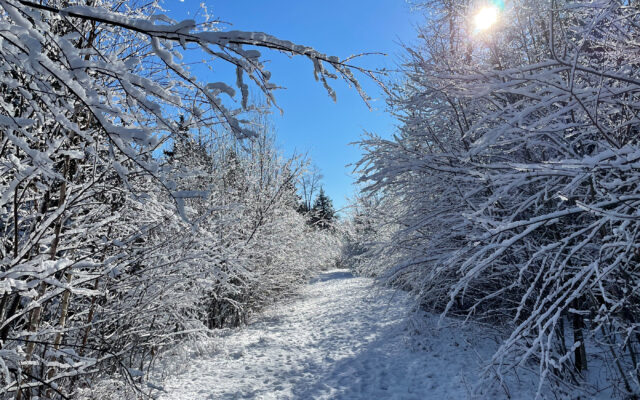
This is the gear you need to enjoy the outdoors all winter long
By Aislinn Sarnacki, Bangor Daily News Staff
This season’s first snow was a sparkling surprise, sneaking in overnight and covering the landscape with a fluffy white blanket. Then, the next day, it snowed again. And instead of melting right away — as first snows like to do — it hung around for a few days.
All of a sudden, it was crucial that I find my ice scraper and snow shovel. And as someone who enjoys hiking year round, I also needed to unearth all of my winter hiking gear.
Winter hiking is a lot like hiking during any other season. But in Maine, you need a few more pieces of clothing and gear to make the activity comfortable and safe.
To kick off the snowy, icy season, I decided to take my dog Juno on an easy hike right down the road from our home. My goal was to enjoy a quiet, snowy forest. No windswept mountaintops or rocky beaches. Just wintery woods.
While hastily preparing for the short hike, it dawned on me that my transition from fall hiking to winter hiking might give readers some holiday gift ideas.
It all started with my base layers (also known as long johns or long underwear). My first line of defense against the cold, the thin pants and long-sleeve shirt are made of merino wool. They cost a pretty penny, but they’re surprisingly warm and durable.
Base layers act like a second skin. They trap in heat and wick away sweat. Often they’re made of soft wool or synthetic materials. If you’ve never invested in a set, I highly suggest it (especially the pants). My base layers allow me to wear a lot of my fall hiking clothes during the winter because they add so much warmth to my outfit.
Dressing for winter hiking is all about layers.
On top of my base layers, I wore water-resistant wind pants, thick wool socks and a fleece jacket under a thin down coat. I also wore thin, down-stuffed gloves and a wool hat.
The forecast was sunny with a high of 30 degrees, so I knew I didn’t need to wear my warmest gear. The bulky mittens, ski jacket and fur-lined hat could stay home.
Into my backpack, I stuffed an extra pair of socks (which can also serve as mittens in a pinch) and chemical hand warmer packets (just in case my fingers or toes got cold). My pack already contained the typical safety, first aid and navigation gear that I always carry.
When I reached the front door, I rooted around in the coat closet for a pair of ice cleats to fit over my hiking boots. I also popped on a pair of gaiters, which are pieces of waterproof fabric that wrap around your ankles, bridging the gap between your boots and pants. They prevent snow from sneaking into the top of your boots, and they help keep your ankles toasty warm.
When I first started winter hiking and snowshoeing, I thought gaiters were overkill. But over the years I’ve grown to appreciate them. They really do add that extra bit of comfort while protecting your ankles and feet.
The snow was just a few inches deep, so I knew I wouldn’t need snowshoes or poles. There would be plenty of time for that later in the season.
The hike was everything I’d hoped: snowy, icy, sunny and quiet. I parked partway down the 1-mile gravel access road to Branch Lake Public Forest, off to the side, then walked to the parking lot at the end. (The road wasn’t plowed and I was nervous that I’d get stuck.)
At the parking lot, we walked around a closed gate to follow a tote road, which led to more than 2.5 miles of marked hiking trails. Consulting the trail map posted at the gate (and at several of the intersections), I decided to follow the Pine Trail to the Lake Loop, which brought us to the windy shore of Branch Lake.
Based on Juno’s excited behavior, I think she enjoys the winter more than any other season. I guess that makes sense, considering she’s half husky. She kept rolling onto her back to thrash around in the snow. She also did a lot of digging, rooting around with her nose and dashing under snow-laden tree branches. I had to keep reminding her that I was attached to the other end of the leash, not a sled that she needed to pull.
During the walk, I noticed boot tracks and dog prints from at least one other visitor. We also spotted (and Juno sniffed at) fresh deer tracks. And we listened to a few chickadees. But for the most part it was just the trees, the snow and us.
Due to my careful consideration about clothing and gear, I was perfectly warm and didn’t slip on the ice. But if I’d failed to wear a hat or ice cleats, it would have been a different experience.
So, if you’re buying gifts for someone who’s looking to get outdoors this winter, there are a lot of options. Here are just a few more tips.
If you’re buying a knit hat, try finding one that’s lined with fleece for extra warmth and protection from the wind. If the gift recipient often has cold hands, opt for insulated mittens paired with chemical hand warmer packs. And for extra cold days, a balaclava or neck gaiter is great for protecting the face.
I wouldn’t worry too much about buying them something they already have. I always appreciate extra gear. That way, I can share with friends and enjoy a little company on the snowy trails.